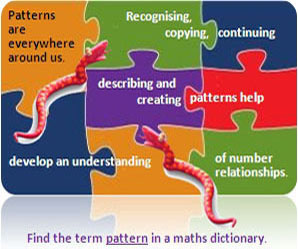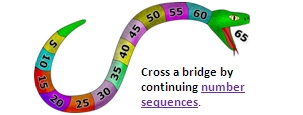Primarily patterns
|
Patterns are everywhere around us. Recognising, copying, continuing, describing and creating patterns help develop an understanding of number relationships. Predict or set counting patternsUse a hundreds chart (PDF 224kB) to help idenitfy and create number patterns. ABCYa has an interactive hundred square, and this is a more advanced one that can go to 1000. Shodor has a single operation function machine. Math Games have a large number of self-marking practice and review questions broken up by year. PhET has a series of interactives that introduce multi-operation functions. |
Early Stage 1 and Stage 1Match and continue coloured bead patterns. Complete a pattern of shapes or shape characters. Learn about repeating patterns in the world. Practice skip counting in Number Bubble or choose what comes next in Pattern mania. Stage 2 and Stage 3Mathforlove.com has a variety of interesting activities that emphasise creativity and exploration. Easy to access, lots of space in the problems to explore. Use the following Geogebra interactives to produce square and triangular numbers. Balance number sentences and investigate different number patterns. PhET has a series of interactive equation balancing activities that build from numbers and shapes to variables and operations. |
For teachersAccess resources for mathematics teaching, as well as Best Start Kindergarten Assessment resources. NRICH has lots of resources, including games and interactive worksheets, and they have teacher-focused material as well (refers to UK curriculum). Here are some puzzles that should spark discussion about patterns and strategies. Shodor has lesson plans based on exploring Pascal's Triangle and linking to fractals, including interactive applets. GeoGebra can be used to explore patterns and help visualise graphing algebra. Register at learningclip for free to get access to interactives and videos on number patterns and sequences. The Fibonacci sequence is a great link between the patterns that we see in algebra and patterns in the world outside the classroom. Geogebra has lots of visualisations of constructing spirals, but you can also use it to explore the relationship between numbers in the sequence. Assess Stage 2 students’ understanding of counting rules. See also Sites2See: Number, Measurement and Space and Geometry for Primary. |


